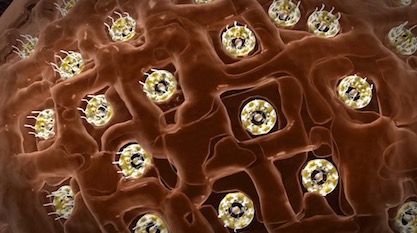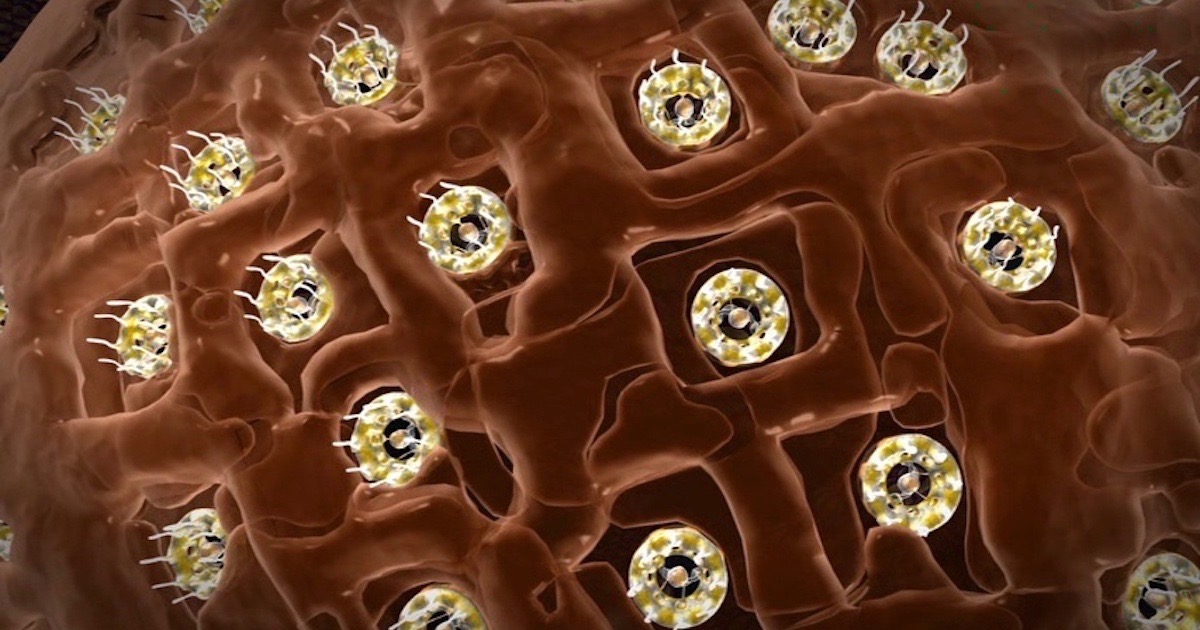 Life Sciences
Life Sciences
How the Nucleus Guards Its Gates


The nuclear pore complex (NPC), which we mentioned briefly here and here, has been a prime target of research for years now, ever since biochemists realized how large it is and the vital role it plays guarding what moves in and out of the nucleus. The NPC has to validate cargo large and small through its hoop-like opening with dangling ends that resemble a basketball net. Caltech scientists describe it with words that sound ready for a treatise on intelligent design:
Standing guard between a cell’s nucleus and its main chamber, called the cytoplasm, are thousands of behemoth protein structures called nuclear pore complexes, or NPCs. NPCs are like the bouncers of a cell’s nucleus, tightly guarding exactly what goes in and out. Each structure contains about 1,000 protein molecules, making NPCs some of the biggest protein complexes in our bodies. One of the most notable clients of NPCs is a class of molecules known as messenger RNAs, or mRNAs. These are the messengers that carry genetic instructions from the nucleus to the cytoplasm, where they are then translated into proteins. [Emphasis added.]
Moreover, the article goes on to say, mRNAs, though being one of the largest cargoes ferried through the NPC, make it through the whole process in a fraction of a second. That’s amazing. A large ship shimmying through the Panama Canal would love that kind of efficiency!
A Great “Unsolved Problem in Biology”
The Caltech researchers pursued new ways to look at mRNA translocation, because “How this works has been one of the greatest unsolved problems in biology.” To make some progress, they figured out ways to tag some of the hundreds of proteins involved with fluorescent barcodes and image them in stages. This allowed them to build up a rough time-and-motion study of a messenger RNA passing through the “locks” of the NPC channel.
The NPC has tags of its own. A molecule can’t get through without a ticket.
In a new study in the June 13 issue of Nature Communications, Hoelz and his group… report the first atomic-scale look at the specific components of human NPCs responsible for dropping mRNAs off in the cytoplasm. For an mRNA to be transported through an NPC, it must be tagged with a nuclear export factor, a type of small protein. That tag is like a ticket that allows the mRNA to enter the central transport channel of the NPC. Once the mRNA reaches the cytoplasmic side, it must surrender the ticket — otherwise, the mRNA could travel back into the nucleus, and the proteins it encodes wouldn’t get made.
It was enough of a challenge to figure out that one step, how the ticket is surrendered. To study it, they had to figure out the crystal structure of human Gle1, an essential component of the NPC validation system. Unlike its counterpart in yeast, Gle1 was found to be stabilized by Nup42, one of dozens of “nucleoporin” (Nup) proteins. Another protein named DDX19 un-tags the molecule as it exits.
Photobomb by Darwin
The scientists marveled that yeast Gle1 was almost identical to human Gle1. Caltech offers rotating images of the proteins. They’re hard to tell apart. That’s when Darwin came in for a brief photobomb, escorted by Daniel Lin, a Caltech grad now at MIT.
“Even with billions of years of evolution between yeast and humans, there are still aspects of our bio-machinery that remain the same,” says Lin.
The paper in Nature Communications, by the way, is remarkable for its repeated mention of genetic conservation — not evolution — between the two forms of Gle1. Of eight hits on the word “evolution” in the paper, fully seven of them say “evolutionarily conserved,” meaning that no evolution has occurred. And the last mention will give no comfort to Darwinians:
Strikingly, the Gle1CTD•Nup42GBM interaction mechanism is virtually identical in species separated by more than a billion years of evolution.
For a process that supposedly leads to continual gradual change, that is “striking” indeed. They try to explain it away:
“Gle1 is essential for life to function properly,” says Hoelz, “so any mutations that cause it to be less stable are going to cause problems.”
This rationalization leads to follow-up questions. Are any processes not essential for life? Then why did “survival of the fittest” evolve them? Has Gle1 reached mutational nirvana, such that no further changes are possible? Then how did it function before it reached perfection? Aren’t mutations the seed plot of innovation? Why, then, are they saying that mutations cause problems? Mutations do, in fact, cause problems:
NPCs are associated with several diseases. Mutations to proteins within the complex have been linked to motor neuron diseases such as amyotrophic lateral sclerosis (ALS), and people with Huntington’s disease are known to have defects in the function of their NPCs.
You don’t want to mess with an unevolved, conserved, efficient mechanism like NPC translocation. But enough about evolution.
Let’s Look for Design in the Paper
Four instances of “efficiently” can be seen in the paper, such as “A portion of this gap could be explained by a specific spatial organization at the cytoplasmic face of the NPC that efficiently accelerates the DDX19 cycle.” We also find frequent design words like architecture, information, and organization. Here’s a good example to inspire awe for the NPC that uses the word “decorate” in passing. (Note: MDa, or MegaDalton, is a measure of molecular mass where one Dalton is one atomic mass unit. A kda or kilodalton roughly equals 333 amino acids. An MDa is a thousand times larger.)
The flow of genetic information requires newly transcribed and processed mRNAs to be exported from the nucleus to the cytoplasm through nuclear pore complexes (NPCs). NPCs are massive macromolecular machines perforating the nuclear envelope, each composed of ~1000 protein subunits (collectively termed nucleoporins) totaling to a molecular mass of ~120 MDa in humans. By fusing the inner and outer nuclear membranes, NPCs create pores through the nuclear envelope and simultaneously generate a passive diffusion barrier composed of disordered protein sequences enriched in phenylalanine-glycine (FG) repeats. Each NPC is composed of a ~60 MDa symmetric core that is decorated by different proteins on its nuclear and cytoplasmic faces, which are referred to as the nuclear basket and cytoplasmic filament nucleoporins, respectively (Fig. 1a).
We also learn that:
Preparation of mRNAs for nuclear export is a highly coordinated process that begins co-transcriptionally and results in the addition and removal of mRNA-binding proteins during transcription and nuclear processing until an export-competent messenger ribonucleoprotein particle (mRNP) is formed.
Multiple levels of quality control can be seen in action here. The ticketing process begins as the gene is transcribed. It is re-checked by “nuclear processing” inside the nucleus. Only when the mRNA is “export competent” can it pass the NPC. As it passes through, its ticket is removed, so that it cannot return. “This spatial regulation of activity prevents re-import of mRNPs into the nucleus, and thus ensures the directionality of mRNA export.” The NPC has all the marks of a programmed system with built-in quality control. It is very rapid, working in just fractions of a second. It’s even environmentally friendly; all the parts are recycled. And there are thousands of these little factories in each nuclear envelope. Then there’s this minor miracle of coordination: at cell division, the entire nuclear envelope, with all its NPCs, is torn down and reconstructed.
Someday perhaps it will no longer be necessary to gratuitously insert Darwin in scientific papers that otherwise show great examples of design. Unless you are dying of a deadly NPC disease, caused by a mutation, your NPCs are probably all working as they should, as they did in your parents, your grandparents, and as far back as you can see. That’s a level of automated, programmed design far superior than anything humans have ever achieved.
Image: NPCs (nuclear pore complex), from Origin: Design, Chance and the First Life on Earth, courtesy of Illustra Media.


